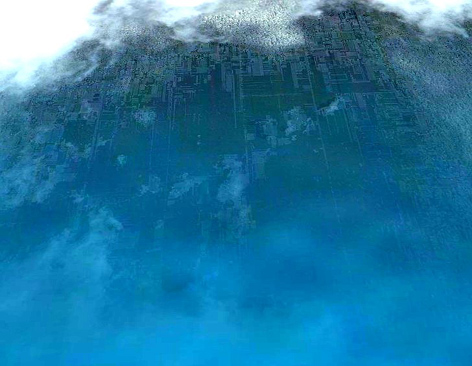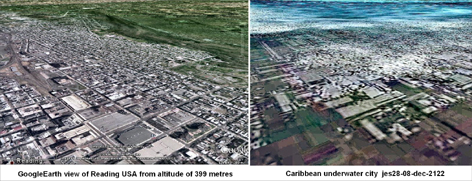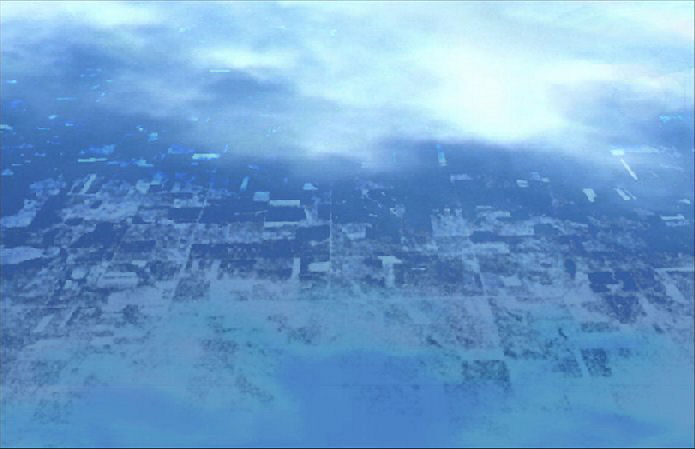ALLEGED
UNDERWATER CITY FOUND IN THE CARIBBEAN - IS IT A SPOOF?
Looks
amazing, doesn't it. But is it a lost underwater
city?
For the answer see below. (Pic credit: Herald
de Paris)
EXCLUSIVE
REPORT BY ANDREW COLLINS
ALLEGED
UNDERWATER CITY FOUND IN THE CARIBBEAN - IS IT A SPOOF?
Looks
amazing, doesn't it. But is it a lost underwater
city?
For the answer see below. (Pic credit: Herald
de Paris)
EXCLUSIVE
REPORT BY ANDREW COLLINS
An
underwater city, complete with roads, structures, and perhaps even pyramids, has
been discovered beneath the shallow blue waters of the Caribbean. Yes, they are
fantasy headlines that every ancient mysteries reader dreams about. But is it
true? Or it is a spoof, a psychological experiment, to test the minds of the gullible
and inquisitive, in time for a little Christmas cheer?
Let's examine the story so far . . .
December 9th saw the appearance of a press statement under the headline "Previously undiscovered ancient city found on Caribbean sea floor". It appeared on a news website called Herald de Paris. Click here to read.
The story, penned by the site's founder Jes Alexander, announced that "researchers" have released images showing the presence on the sea bottom, someone in Caribbean waters, of what was believed to be "the archaeological remains of an ancient civilization".
It claimed that the coordinates for the location were being withheld, which seems sensible, but more mysterious is that the "project's leader" has chosen to remain anonymous, which does not help convince the greater public of what is being claimed here.
And
what has been found? Well, the anonymous "team leader" reckons that
the underwater city, apparently found using "advanced satellite imagery",
could be "thousands of years old; possibly even pre-dating the ancient Egyptian
pyramids, at Giza."
No
Connection to Cuban Claims
This is possible, but, curiously, the author
of the new story seems keen to emphasize that the new discovery "is not in
any way associated with the alleged site found by Russian explorers near Cuba
in 2001, at a depth of 2300 feet."
This refers to the announcement in that year of the discovery of a series of seemingly rectilinear structures in deep water off the west coast of Cuba. At the time, the story went off the scales with public interest, but the discoverers, a Canadian registered salvage company, whose usual job description was searching for shipwrecks, ran out of money before they had a chance to deliver any concrete evidence of what they had found. To read the full story click here.
Why Jes Alexander should want to make it clear that what the "researchers" have found in the Caribbean has nothing to do with this story from nine years ago is unclear, stating only that the new site is "much shallower."
Large parts of the coastal areas of both the Caribbean and neighbouring Bahamas have extremely shallow waters, usually no more than five to ten meters in depth. The series of pictures released to date do indicate underwater features in fairly shallow water. Yet what exactly are we seeing in the pictures?
"You have to be careful working with satellite images in such a location," the "project's principle researcher" admits. However, he adds: "The digital matrix sometimes misinterprets its data, and shows ruins as solid masses."
This is indeed true, and what you think are artificial features, such as rectilinear structures and roads, can turn out to be natural features. Having said this, looking at the various pictures it is almost as if you are gazing down at a modern city submerged beneath the waves.
In fact, this has left readers of the news story dubious of what they are seeing. D. Howerton, for instance, comments on the Herald de Paris site: "I am skeptical because the city is laid out like ours today. In the upper center part of the main photo there is what appears to me to be an airport with a single runway connected to a parking apron. … There are other details that make me believe the pictures are not of an ancient city, just intentionally or otherwise bad photography."
Not helping matters is that the press story claims that the "researchers" behind the discovery have identified various built structures, including "a tall, narrow pyramid; large platform structures with small buildings on them", and even a "standing parallel post and beam construction in the rubble of what appears to be a fallen building", something that for them confirms "human involvement".
Is
this Atlantis? Er, No
Despite such tall claims, the researchers have
been keen to detach their alleged discovery from the dreaded A-word - Atlantis.
As they say: "The romanticized ideal of Atlantis probably never existed, nor will anyone ever strap on a SCUBA tank, jump in the water, and find a city gateway that says, 'Welcome to Atlantis.'"
That's probably true, but dismissing the whole Atlantis myth is probably inappropriate, especially as everybody else in the world will be thinking "Is this Atlantis?". Well, everyone other than those writers who have convinced themselves that Plato's lost city is off the Greek island of Santorini, or Crete, or Cyprus, or somewhere that it just shouldn't be according to the works of the great philosopher.
For the record, writing in the Timaeus, some time around 350 BC, Plato made it clear that the "Atlantic Island", i.e. Atlantis, was located BEYOND the Pillars of Hercules - the rocky headlands on each side of the Straight of Gibraltar marking the point of no return if you were sailing beyond the Mediterranean into the Atlantic Ocean.
Plato additionally revealed that Atlantis, which controlled an island empire spread out across the Atlantic, was once accessible to "voyagers" from his own world, and that beyond Atlantis were smaller islands used by ancient mariners as stepping stones to reach the "opposite continent", i.e. America.
In my book GATEWAY TO ATLANTIS, published in 2000, I found persuasive evidence that the Atlantean flagship was the Caribbean island of Cuba, with the drowned regions of the Bahamas and Caribbean being the Atlantean empire's sunken kingdom, destroyed according to Plato in "one day and one night" of earthquakes and floods, a memory perhaps of a cataclysm long since forgotten. See andrewcollins.com's Atlantis Files (click here) for a full run down on the Cuba-Atlantis theory.
So if the new discovery in the Caribbean is not Atlantis, then what is it? The researchers say that their underwater "city" might be one of "many cities of an advanced, seafaring, trade-based civilization, which may have been visited by their Eurocentric counterparts."
That's actually a sensible statement, as the work in recent years of US explorers Dr Gregory and Dr Lora Little has gone a long way to proving that the Bahaman islands were used as ports by ancient voyagers. Click here to read more about their discoveries.
The Littles' diving expeditions off the coasts of islands such as Bimini, Andros and Cay Sal, just north of Cuba, have revealed the existence of submerged stone walls and structures that would seem to have functioned as quays and breakwaters for some unknown maritime culture. These loose stone formations, which are not simply natural features, lie on prehistoric shore lines that date to anywhere between 4000 and 1500 BC, the timeframe of Phoenician and Iberian exploration into the Atlantic Ocean. Indeed, very similar stone formations, utilizing available beach rock, exist off ancient Mediterranean ports, making the connection with the ancient world even more realistic.
Whether any of this has any relevance to the supposed discovery of an underwater city on the Caribbean seafloor is debatable. The "researchers" admit that at this time it would be impossible to date the submerged features, but say: "We have several theories."
Any theories should include the clear fact that if the underwater features do exist, then because they are in relatively shallow water, they cannot be any more than a few thousand years old. Ever since the end of the last Ice Age, c. 10,000-9000 BC, coastal waters around the world have been rising in fits and starts, sometimes fast, sometimes more slowly. Any built structures in anywhere between five and ten metres of water will have been above the water in the not too distant past.
Apparently, the researchers are keen to begin their investigations, mapping and exploring the site, before they intend turning it over to "the Caribbean island's home government".
As they say: "Whatever we've found does not belong to us. It belongs to the people of this island, and to the world at-large. If any pieces are brought to the surface, they belong in the hands of a museum."
The press statement ends with an appeal from the Herald de Paris' website's founder, and "publisher", Jes Alexander. He asks that if anyone wants further information, or wants to sponsor this project, they should ring a special hotline set up solely for this purpose. I rang the number given, and found myself being diverted to the user's voice mail. I tried it later - still on call divert.
Meanwhile, the series of pictures released of the alleged site are not convincing those who I work with investigating the mysteries of the past.
"My initial reaction is hoax," one close colleague, journalist and writer David Southwell, said. "It is the tone of the article. lt does not read right."
This was also the response of Rodney Hale, another trusted colleague working in the field of electronic engineering and digital technology: "I would say a hoax," he says. "If the images were taken from an orbiting satellite, you would not get the perspective effect from that height."

 | Above left, Rodney Hale's quick comparison of the GoogleEarth aerial view of Reading, USA, with a released picture of the supposed underwater city, above right (pic credit: Herald de Paris. On the left is Rodney Hale's first attempt at recreating the impression of roads and structures under the sea using Photoshop techniques. It can easily be done. |
More disconcerting is another trusted colleague's valued first opinion, which simply reads: "This is complete nonsense....a spoof."
Oh well, just maybe they are wrong. I doubt it, though, this probably is just a psychological experiment to divert me from my real work for a day or so.
But if, after reading this, you still want to approach this fantastic story with any kind of open mind, then I strongly advise you tread very carefully indeed. Remember, you have been warned.
Now,
where's that number again . . .
| To
purchase: GATEWAY TO ATLANTIS: The Search For The Source Of A Lost Civilisation Paperback 436pp Headline, 2001 |